182 Search Results for asha
January 8, 2015
by Carole Zangari -
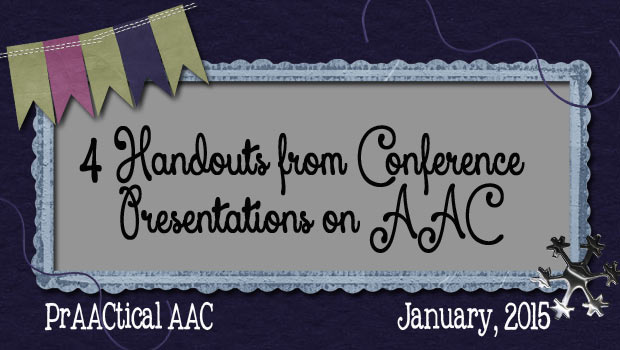
Travel budgets are limited these days and we can’t always get to the conferences we’d love to attend. In case that happens to you, too, here are some presentation handouts on AAC-related topics from ISAAC 2014, ASHA 2014 and other conferences. Gloria Soto, Dan Phillips, and Michaela Sullivan on Strategies for SLPs Working With Students With AAC Needs in Schools Gretchen Hanser on Writing for Students with Angelman Syndrome Penny Hatch and Allison Dennis on Getting to the Core: Creating a Core Vocabulary for the Common Core Amy Wetherby on the trajectory of development for toddlers with developmental disabilities
November 26, 2014
by Carole Zangari -

Between the ASHA Convention and preparations for Thanksgiving, we’re dragging. Luckily, comedian Lee Ridley (“The Lost Voice Guy”) is ready to give us a smile.
November 25, 2014
by Carole Zangari -
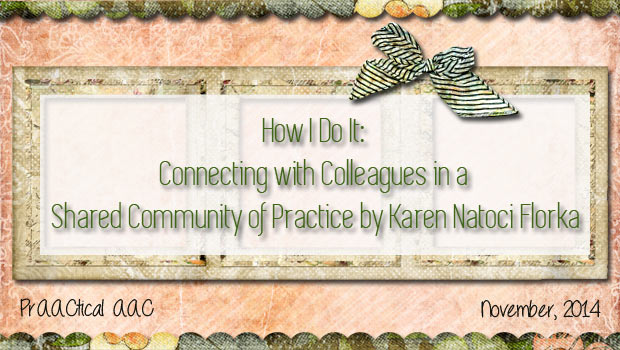
I had the pleasure of meeting Karen Natoci Florka last month when I visited Michigan and am delighted that she was willing to introduce us to the Shared Community of Practice from the team at The Communication Matrix. Karen is an SLP who has served students aged 3-26 with various physical, sensory and intellectual challenges at Wing Lake Developmental Center (Detroit area) since 2001. She is a part time lecturer at Wayne State University where she teaches a course entitled “Communication Acquisition and Educational Interventions for Students with Moderate to Severe Impairments.” She is part of the Communication Matrix Charter group. Click on the image below to learn more. The Communication Matrix is growing into a Shared Community of Practice! I remember the first few weeks in my new job at a wonderful, magical, school for children with complex communication needs. It was time for my first evaluation. These amazing students were challenging! They seemed... [Read More...]
November 20, 2014
by Carole Zangari -
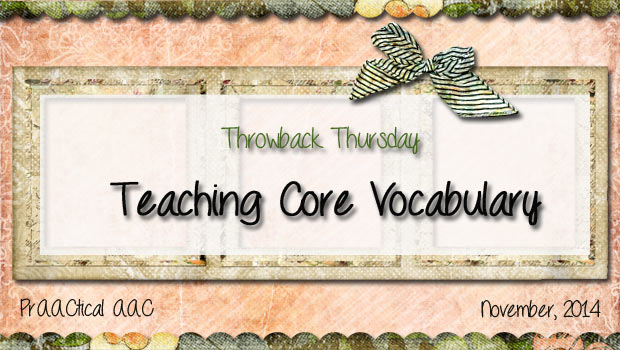
While I’m soaking up AAC knowledge at the ASHA Convention, here’s a post from the past. :::::::::::::::::::::::::::::::::::::::::::::::::::::::: Among the many changes that the AAC field has experienced in the last decade is the notion that core vocabulary is (or should be) an integral part of any AAC system. We grew to understand the limitations of AAC supports that consist primarily of nouns and descriptors, realizing that those kinds of communication displays restricted our clients to requesting and labeling. Our field realized the inadequacy of providing only prestored messages (e.g., limited the client’s ability to communicate anything novel, not flexible enough to meet most communication needs, etc.). In essence, we realized that without core vocabulary, we were imposing a ceiling on language development. We’re thrilled to see so many communication boards, books, SGDs, and AAC apps reflect this knowledge. Having tools with the appropriate vocabulary is a big step in the... [Read More...]
November 4, 2014
by Carole Zangari -
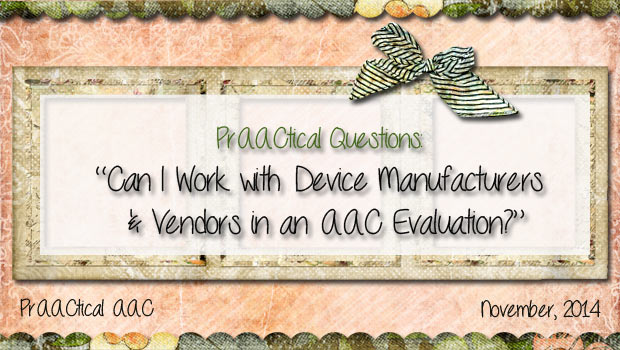
In one of my AAC classes, we’ve been talking about working collaboratively with vendors of SGDs and other AT in a way that is ethically responsible. Clearly, we look first to our ASHA SLP Code of Conduct, best practices, agency policies and procedures, and regulations (such as HIPAA and FERPA in the US). Secondly, we use a feature match process to guide the evaluation so that there is appropriate diversity in the communications being considered. Beyond that, here are some of the things we came up with. Open a dialogue and the roles and expectations of each party. If we are inviting a vendor in to provide some support, then it’s best to precede that with a frank conversation so that everyone is clear on how to proceed. Be clear about acceptable and unacceptable behaviors prior to the start of the collaborative activity. Having some guidelines written out in advance... [Read More...]
October 24, 2014
by Carole Zangari -
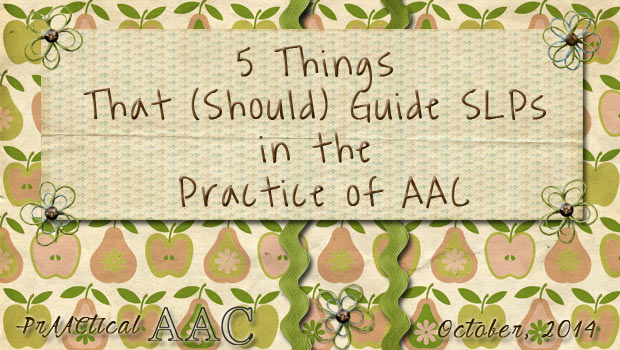
Providing good AAC services is messy stuff. To start with, language therapy can’t be tied up into neat little packages. Add in motor skills, symbolization, perceptual abilities, the technology, and all the rest of it and you can see why SLPs new to AAC get overwhelmed. Here are some resources we turn to when trying to blaze a path to communicative competence with our AAC friends. ASHA’s Roles and Responsibilities of SLPs with Respect to AAC National Joint Committee (NJC) Position Statement on Eligibility to Communication Services Developmental Patterns for Syntax and Morphology Data from a Comprehensive AAC Assessment ASHA Code of Ethics
October 14, 2014
by Carole Zangari -
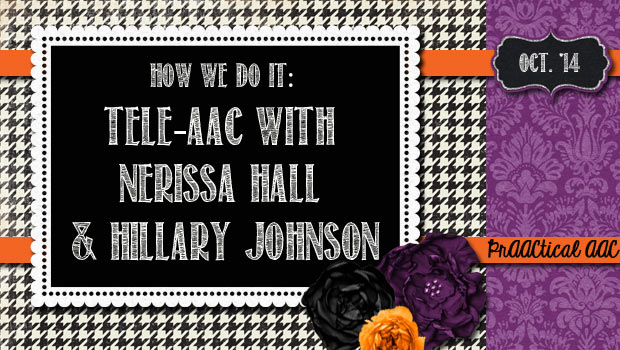
Have you been hearing a lot about telepractice lately and are wondering how that works when the client has AAC needs? In this post, we turn to Nerissa Hall and Hillary Jellison of Communicare who tell us how they use it in their clinical practice. Nerissa and Hillary are both SLPs and assistive technology practitioners specializing in AAC, AT, and telepractice/tele-AAC. They have worked together for a number of years and are the proud owners of Commūnicāre, LLC, organization based in Western Mass and CT, that offers intervention, consultation, and evaluation services focusing on supporting an individuals, or a team’s, success and independence through implementation of AAC, AT and innovative and evidence-based practices. We are committed to our clinical work, as well as translational research and are members of the C.A.R.E. Consortium. Tele-AAC: A Powerful Way of Supporting Individuals Using AAC Telepractice, which is used to provide professional services by linking clinicians... [Read More...]
September 19, 2014
by Carole Zangari -
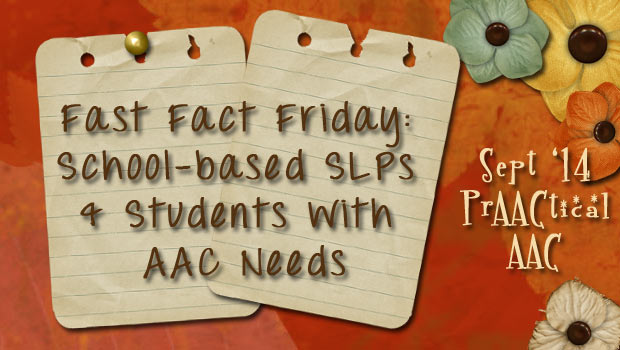
If you’re up for a little light reading this weekend, you might want to check out ASHA’s 2014 SLP Schools Survey Caseload Report. Among the findings: 55% of school-based SLPs regularly serve students with AAC needs 90% of them serve kids with ASD. The largest median caseload (60) was in Florida, and the smallest (35) was in New York. ::::::::::::::::::::::::::::::::::::::::::::::::::::::::::::::::::::::::::::::::::::::::::::::::::::: Reference American Speech-Language-Hearing Association. (2014). 2014 Schools Survey report: SLP caseload characteristics. Available from www.asha.org/research/memberdata/schoolssurvey/.
September 5, 2014
by Carole Zangari -
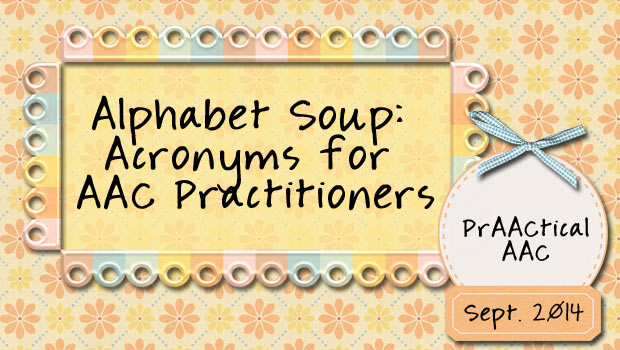
We’re excited about the passion and enthusiasm for AAC shown by many new SLPs and graduate student clinicians. One of the things they sometimes struggle with in reading and writing reports is the number of acronyms that we tend to use. This is always a problem in clinical and scholarly writing, but when the field is incredibly diverse and transdisciplinary, the challenges multiply. Here’s a starter list of acronyms* and their meanings. Many, MANY thanks to those who helped us create this list on the PrAACtical AAC Facebook page. AAC-RERC – AAC Rehabilitation Engineering Research Center ACOLUG – Augmentative Communication Online Users’ Group AiLS, ALgS, and ALs – Aided language stimulation ALI – Aided language input ALS – Amyotrophic lateral sclerosis AOTA – American Occupational Therapy Association APTA – American Physical Therapy Association ASD – Autism spectrum disorder ASHA – American Speech Language Hearing Association AT – Assistive technology ATIA... [Read More...]
July 15, 2014
by Carole Zangari -
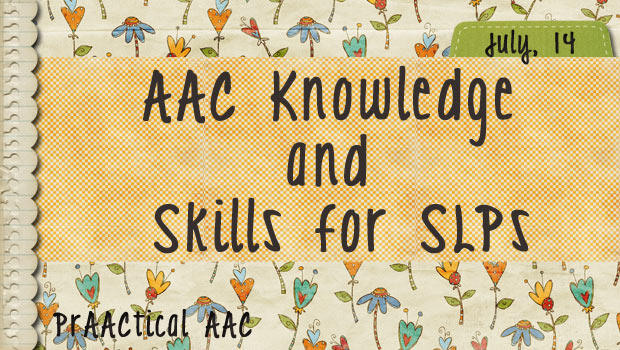
What should SLPs know and be able to do in order to provide AAC services? Here’s what ASHA has to say about that. ::::::::::::::::::::::::::::::::::::::::: American Speech-Language-Hearing Association. (2002). Augmentative and alternative communication: knowledge and skills for service delivery [Knowledge and Skills]. Available from www.asha.org/policy.









